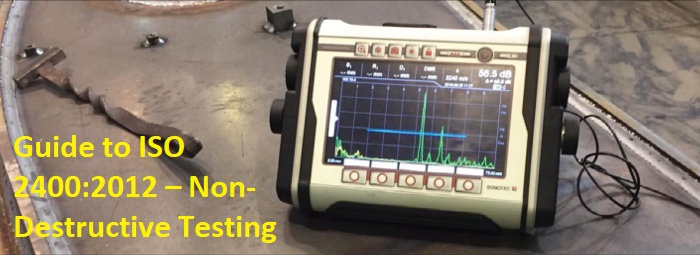Introduction
Welcome to MechDNA’s comprehensive guide on ISO 2400:2012, the international standard for non-destructive testing (NDT) using ultrasonic methods. In this article, we will delve into the various aspects of the standard, covering its scope, normative references, terms and definitions, manufacturing requirements, calibration procedures, and much more. At MechDNA, we believe in the importance of adhering to global standards, and ISO 2400:2012 is no exception. We aim to provide you with in-depth insights into this essential standard that will help you not only meet its requirements but also understand its significance in the field of non-destructive testing.
Scope of ISO 2400:2012ISO 2400:2012 lays down precise requirements for the dimensions, material composition, and manufacturing of a steel block used to calibrate ultrasonic test equipment employed in manual testing. By providing a calibration block, this standard ensures that ultrasonic testing equipment performs accurately and consistently, enabling reliable inspection and evaluation of materials without causing any damage.
- Normative References
To comprehend ISO 2400:2012 fully, it is crucial to consider the normative references that define its application. The following documents are essential for implementing this standard:
- ISO 5577: Non-destructive testing — Ultrasonic inspection — Vocabulary
- EN 1330-4: Non-destructive testing — Terminology — Part 4: Terms used in ultrasonic testing
- EN 10025-2: Hot rolled products of structural steels — Part 2: Technical delivery conditions for non-alloy structural steels
These references establish the fundamental terminology and technical aspects that align with ISO 2400:2012, facilitating seamless integration of the standard’s provisions into ultrasonic testing practices.
- Terms and Definitions
To ensure clarity and consistency in communication, ISO 2400:2012 adopts the terms and definitions specified in ISO 5577 and EN 1330-4. These definitions encompass key concepts in non-destructive testing and ultrasonic inspection, enabling practitioners to interpret and apply the standard accurately.
- Manufacture of Calibration Blocks
4.1 steel
The choice of material is critical to the performance and reliability of the calibration block. ISO 2400:2012 mandates the use of high-quality steel for manufacturing the block. Steel offers excellent acoustic properties and dimensional stability, ensuring consistent and precise calibration results.
4.2 Dimensions
Accurate dimensions are essential for a calibration block to function effectively. ISO 2400:2012 defines specific dimensional requirements, including length, width, and thickness, which must be adhered to during the manufacturing process. These dimensions are carefully determined to cover a range of test frequencies commonly used in ultrasonic testing.
4.3 Machining, Heat Treatment, and Surface Finish
The manufacturing process involves precise machining to achieve the required dimensions and surface finish. Heat treatment is performed to ensure the block’s internal structure remains stable and free from internal stresses. The surface finish of the block should be smooth and free from any defects that could impact its performance.
4.4 Reference Marks
Reference marks on the calibration block aid in the accurate positioning of transducers during testing. ISO 2400:2012 outlines the specifications for these marks to ensure consistent and reliable alignment during calibration and inspection procedures.
- Velocities
The standard also addresses the determination of velocities of longitudinal and transverse waves within the calibration block. Accurate knowledge of wave velocities is crucial for calibrating ultrasonic testing equipment and interpreting inspection results. ISO 2400:2012 provides detailed guidelines for conducting velocity measurements and emphasizes the importance of precise calculations.
- Marking and Declaration of Conformity
Proper marking of the calibration block is necessary to identify its compliance with ISO 2400:2012. The standard defines the required information to be included on the block, such as its serial number, material grade, and conformity statement. The declaration of conformity certifies that the calibration block adheres to the specified requirements and has undergone necessary testing.
- Possible Modifications to Block No. 1
While ISO 2400:2012 primarily focuses on a standard calibration block design, it also acknowledges that certain applications may necessitate modifications. The standard offers guidelines for introducing changes to Block No. 1 while ensuring its continued compliance with the standard’s overall objectives.
- Existing Blocks
ISO 2400:2012 recognizes the use of existing calibration blocks that were manufactured before the introduction of the standard. It provides insights into the assessment and verification of the suitability of such blocks for current testing purposes, ensuring that they meet the required quality and accuracy levels.
Conclusion
Mech DNA hopes that this comprehensive guide to ISO 2400:2012 has provided you with valuable insights into the world of non-destructive testing using ultrasonic methods. Adhering to this standard is crucial for maintaining the highest level of accuracy and reliability in your ultrasonic testing processes. By following the guidelines outlined in ISO 2400:2012, you can confidently calibrate your ultrasonic test equipment and ensure consistent and accurate inspection results. As experts in the field, Mech DNA is committed to promoting best practices in non-destructive testing, and we trust that this article will serve as a valuable resource for professionals and practitioners in the industry.
